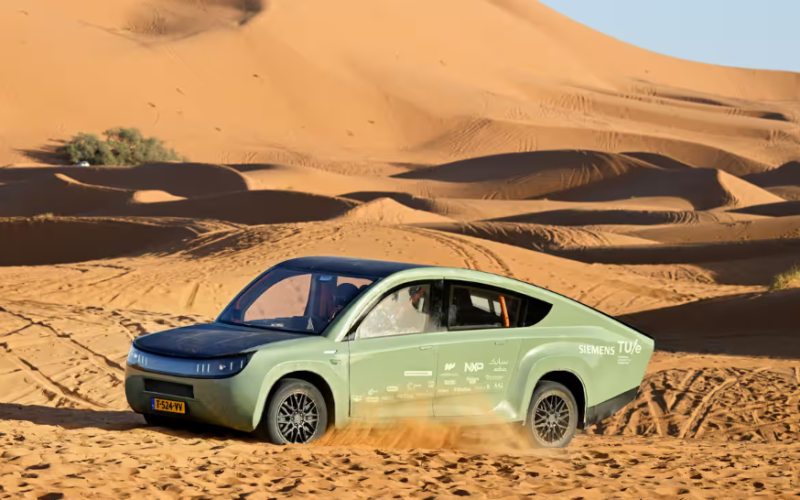In a remarkable feat of engineering innovation, the world’s first off-road solar-powered car has successfully completed a grueling 620-mile (1,000km) test drive across the diverse landscapes of Morocco and the challenging terrain of the Sahara Desert. This groundbreaking vehicle, known as Stella Terra, was conceived and developed by a team of students from the Eindhoven University of Technology, setting new standards for sustainable, long-distance travel.
The Stella Terra is a two-seat marvel of sustainable engineering, raising the bar for off-road mobility and renewable energy use. The car relies solely on the power generated by a multitude of solar panels adorning its roof. This remarkable innovation allows the Stella Terra to cover extensive distances without the need for recharging, even in the challenging conditions of the Sahara.
This exceptional solar-powered vehicle boasts an array of impressive features:
- Off-Road Prowess: Stella Terra defies traditional electric cars by proving its worth off the beaten path, successfully traversing Morocco’s varied landscapes and the arid Sahara.
- Speed and Efficiency: With a top speed of 90mph (145 kmph), Stella Terra combines power with efficiency, making it a viable option for both urban and rugged environments.
- Lightweight Design: Weighing a mere 1,200kg (1.2 tons), Stella Terra’s lightweight frame is a testament to its forward-thinking approach.
- Remarkable Range: Even on a sunny day, Stella Terra offers an impressive range of at least 440 miles (710km), making it a versatile choice for long journeys.
Wisse Bos, the team manager of Solar Team Eindhoven, emphasized that the technology used in Stella Terra is at least a decade ahead of anything available in the current market. This cutting-edge design pairs a lightweight frame with highly efficient solar panels, making it a sustainable solution for long-distance travel.
The car features a rechargeable lithium-ion battery, ensuring it can continue operating in less sunny climates and cover shorter distances without any difficulties. The energy harnessed by the solar panels on the vehicle is so abundant that it can also power other essential functions, such as cooking, or charge devices like phones and cameras.
Stella Terra, the brainchild of a group of 22 students aged between 21 and 25, was brought to life after they took a year off from their studies. This ambitious project showcases the power of youthful innovation and dedication, promising a brighter, more sustainable future for transportation.
While Stella Terra’s achievements are laudable, they also highlight the significant manufacturing costs associated with breaking into the automotive market with solar-powered cars. Companies like Atlas Technologies, a subsidiary of the Netherlands-based Lightyear, have faced challenges in this endeavor. Their initial attempts at solar-electric cars, priced at €500,000, did not find enough buyers, leading to bankruptcy. However, they have since reemerged with a new, more affordable model, aiming to create a vehicle that costs around $40,000 and can travel up to 500 miles between charges.
Stella Terra stands as a testament to the potential of solar energy to revolutionize the way we travel. As solar technology continues to advance, vehicles like the Stella Terra may soon become a common sight on the world’s roads, offering eco-friendly, long-distance mobility solutions for the future.








